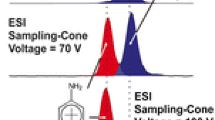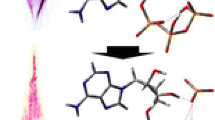Abstract
Purpose. A surface sensitive mass spectrometric technique: Time ofFlight Secondary Ion Mass Spectrometry (ToF-SIMS) was introducedto study the solid state instability of a methionine containing peptidecaused by the oxidation of the methionine residue.
Methods. The oxidation of a neuropeptide Methinonine-Enkephalin(ME) in air and under UV acceleration was studied by ToF-SIMS.
Results. The apparent oxidation rate is defined by the peak ratio ofoxidized molecular ion over unoxidized molecular ion. ME is oxidizedat a faster rate to its sulfoxide derivative in the UV accelerated oxidationenvironment than in lab air. The calibration curve for evaluating theionization probability ratio of the oxidized deprotonated molecular iondivided by the unoxidized deprotonated molecular ion was obtained.This could be used to extract the real oxidation rate of ME in thesolid state.
Conclusions. The preliminary results showed that ToF-SIMS with simplesample handling, fast data acquisition, together with excellentsurface sensitivity and detection limit could be an applicable and convenienttool to study peptide reactions in the solid state such as oxidationand deamidation process.
Similar content being viewed by others
REFERENCES
S. Li, C. Schoneich, G. S. Wilson, and R. T. Borchardt. Chemical pathways of peptide degradation.V. Ascorbic acid promotes rather than inhibits the oxidation of methionine to methionine sulfoxide in small model peptides. Pharm. Res. 10:1572–1579 (1993).
T. H. Nguyen, J. Burnier, and W. Meng. The kinetics of relaxin oxidation by hydrogen peroxide. Pharm. Res. 10:1563–1571 (1993).
J. L. Liu, K. V. Lu, T. Eris, V. Katta, K. R. Westcott, L. O. Narhi, and H. S. Lu. In vitro methionine oxidation of recombinant human leptin. Pharm. Res. 15:632–640 (1998).
C. S. Hayes, B. Illades-Aguiar, L. Casillas-Martinez, and P. Setlow. In vitro and in vivo oxidation of methionine residues in small, acid-soluble spore proteins from bacillus species. J. Bacteriol. 180:2694–2700 (1998).
M. C. Lai and E. M. Topp. Solid-state chemical stability of proteins and peptides. J. Pharm. Sci. 88:489–500 (1999).
J. Fransson, E. F. Robertsson, K. Axelsson, and C. Nyhlen. Oxidation of human insulin-like growth factor I in formulation studies: kinetics of methionine oxidation in aqueous solution and in solid state. Pharm. Res. 13:1252–1257 (1996).
A. Adriaes, L. V. Vaeck, and F. Adams. Static secondary ion mass spectrometry (S-SIMS) part 2: material science applications. Mass Spectrom. Rev. 18:48–81 (1999).
J. Li, R. W. Johnson, Jr. and J. A. Gardella, Jr. Secondary ion mass spectrometry as applied to thin organic and polymeric films produced by Langmuir Blodgett and Self Assembly. In A. Ulman (eds.), Characterization of Organic Thin Films, Volume 12 of Materials Characterization Series: Surfaces, Interfaces, Thin Films of Materials, Manning, Greenwich, CT, 1995, pp. 193–212.
J. Chen and J. A. Gardella, Jr. Time-of-Flight secondary ion mass spectrometry studies of in vitro hydrolytic degradation of biodegradable polymers. Macromolecules 32:7380–7388 (1999).
G. K. L. Tiong and J. E. Olley. A sensitive and specific enzyme-linked immunosorbent assay for methionine-enkephalin sulfoxide. J. Immunol. Methods 131:65–69 (1990).
R. Fruttero, G. Amiconi, F. Ascoli, M. Bolognesi, and P. Ascenzi. Identification of L-methionine oxidation products in tripeptides, in the bovine basic pancreatic trypsin inhibitor:1H and 13C NMR study. Biochem. Mol. Bio. Int. 35:861–874 (1995).
J. A. Kiritsy-Roy, S. K. Chan, and E. T. Iwamoto. Methionine oxidation enhances opioid activity of an enkephalin analog. Life Sci. 32:889–893 (1983).
M. Davies, C. J. Roberts, S. J. B. Tendler, and P. M. Williams. The surface analysis of polymer biomaterials. In J. H. Braybrook (eds.), Biocompatibility Assessment of Medical Devices and Materials, John Wiley & Sons Ltd, Chichester, England, 1997 pp. 66–67.
K. Meyer, B. Hagenhoff, M. Deimel, and A. Benninghoven. Quantification of molecular secondary ion mass spectrometry by internal standards. Org. Mass Spectrom. 27:1148–1150 (1992).
J. Gao, D. H. Yin, Y. Yao, H. Sun, Z. Qin, C. Schoneich, T. D. Williams, and T. C. Squier. Loss of conformational stability in calmodulin upon methionine oxidation. Biophys. J. 74:1115–1134 (1998).
Author information
Authors and Affiliations
Rights and permissions
About this article
Cite this article
Sun, L., Gardella, J.A. The Solid State Oxidation of Methionine Containing Peptide: A Preliminary Study Using Time of Flight Secondary Ion Mass Spectrometry. Pharm Res 17, 859–862 (2000). https://doi.org/10.1023/A:1007516527329
Issue Date:
DOI: https://doi.org/10.1023/A:1007516527329




